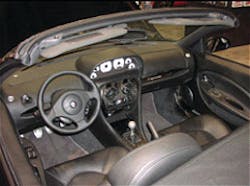Dash-Support Structure
Many fire departments and rescue teams are adopting either one of two rescue evolutions when front-seat occupants are trapped during a collision. It seems that the original evolution of “rolling the dash” is still a viable option for freeing a trapped driver or front-seat occupant. Most commonly done with a power ram, the diagonal push is designed to move everything that is trapping the occupant away from them.
The newer and increasingly popular way of accomplishing the same task is the jacking evolution. Strategic cuts are made in the A-pillar between the front door hinges and a power spreader is used to raise or “jack” the dash, firewall, steering wheel, column and brake pedal.
Design Factors
One vehicle component that is in the dash and instrument-panel design of late-model vehicles can affect a rescue team’s ability to roll or jack the dash efficiently. Many automakers in recent years have added a dash-support pipe component to their dash- and instrument-panel assembly. It is essentially a stiffener, a steel-pipe-and-brace structure that runs from the A-pillar at the top door hinge on the driver’s side to the same area on the passenger’s side of the vehicle. Concealed underneath the instrument panel, it adds strength and crush resistance to the vehicle during a side collision.
The steering column assembly as well as the passenger’s front-airbag inflator unit is typically mounted directly to this dash-support pipe. The dash pipe can be one section of pipe with brackets along the length of the support or it can consist of several sections of pipe and braces welded and bolted together.
Look for Braces
What is important for rescue personnel to understand is how this dash-support pipe helps and also hinders dash rolling or jacking. The dash support can hinder dash movement because of the way it might be supported at its center. To add strength to the center of the dash-support pipe, two steel braces are secured to the floorboard along each side of the “transmission” hump. When a team works to roll or jack the dash, these two braces may hold fast and resist movement of the dash and instrument panel away from the trapped occupants.
If you sense that only the very end of the dash is moving, look to the center-console area. The center braces will be hidden along the outer edges of the radio, heater and defroster controls. Stripping the trim and any of these components away may reveal the bracket. It can easily be cut once it is located. With the brace free of the floorboard, the dash will roll or jack more efficiently.
Rescue Considerations
The dash-support pipe can help make rolling or jacking more effective if it is substantial enough. If the pipe holds its shape and remains a rigid steel design while the dash is moving, rescuers will find that a larger or longer section of the dash and instrument panel will stay intact and move all in one piece. This is a good thing.
Next time – whether you are performing extrication training, looking at junk vehicles in a salvage yard, or working at a vehicle rescue incident – check out the center-console area as well as the area along the center line of the instrument panel. Rescue personnel should have the ability to determine if a dash-support pipe structure exists in a vehicle and should be able to tell if center-support braces are present near the floorboard tunnel.
Ron Moore, a Firehouse® contributing editor, is a battalion chief and the training officer for the McKinney, TX, Fire Department. He also authors a monthly online article in the Firehouse.com “MembersZone” and serves as the Forum Moderator for the extrication section of the Firehouse.com website. Moore can be contacted directly at [email protected].
